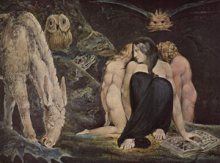Article
A word used by Hillerman to refer to the work of people known in some Native American traditions as witches. In the Navajo tradition, about which Hillerman wrote most often, Navajo witches are also known as Navajo wolves or skinwalkers. In general, it is believed that witches cause physical infections that stem from spiritual imbalances associated with death. Because witches are connected with death (to become a witch in the Navajo tradition, one must murder a family member), all dealings with witches are always already tainted with death and uncleanliness. If one becomes infected with illness because of contact with a witch, or because one is the target of a witch's hex, healing ceremonials need to take place to cure the sickness and help the invalid regain balance, also known as hózhǫ́ . Hillerman used the same term of witchcraft to refer to other evil goings on and unproper behavior for other tribes, like the Hopi.
"The Night of Enitharmon's Joy, Blake's vision of Hecate, Greek Goddess of black magic and the underworld, 1795" by William Blake is licensed under Public Domain.
Manuscripts
A01 The Blessing Way (01-07) p. 13
A01 The Blessing Way (01-07) p. 24
A01 The Blessing Way (01-07) p. 25
A01 The Blessing Way (01-07) p. 31
A01 The Blessing Way (01-07) p. 32
A01 The Blessing Way (01-07) p. 37
A01 The Blessing Way (01-07) p. 50
A01 The Blessing Way (01-07) p. 58
A01 The Blessing Way (01-07) p. 69
A01 The Blessing Way (01-07) p. 72
A01 The Blessing Way (01-07) p. 80
A01 The Blessing Way (01-07) p. 90
A01 The Blessing Way (01-07) p. 92
A01 The Blessing Way (01-07) p. 97
A01 The Blessing Way (01-07) p. 99
A01 The Blessing Way (01-07) p. 101
A01 The Blessing Way (01-07) p. 110
A01 The Blessing Way (01-07) p. 127
A01 The Blessing Way (01-07) p. 161
A01 The Blessing Way (01-07) p. 169
A01 The Blessing Way (01-07) p. 171
A01 The Blessing Way (01-07) p. 233
A05 Listening Woman (02-13), p. 56
A05 Listening Woman (02-13), p. 58
A05 Listening Woman (02-13), p. 59
A05 Listening Woman (02-13), p. 70
A05 Listening Woman (02-13), p. 127
A05 Listening Woman (02-13), p. 156
A06 People of Darkness (03-06) p. 25
A06 People of Darkness (03-06) p. 39
A06 People of Darkness (03-06) p. 41
A06 People of Darkness (03-06) p. 55
A06 People of Darkness (03-06) p. 108
A06 People of Darkness (03-06) p. 206
A06 People of Darkness (03-06) p. 220
A06 People of Darkness (03-06) p. 251
A06 People of Darkness (03-06) p. 272
References
Frisbie, Charlotte J.
1987 Navajo Medicine Bundles or Jish: Acquisition, Transmission, and Disposition in the
Past and Present. Albuquerque: University of New Mexico Press.
Hirschfelder, Arlene and Paulette Molin
2000 Encyclopedia of Native American Religions. New York: Checkmark Books.
Kulckhohn, Clyde and Dorothea Leighton
1946 The Navaho. Cambridge: Harvard University Press.

